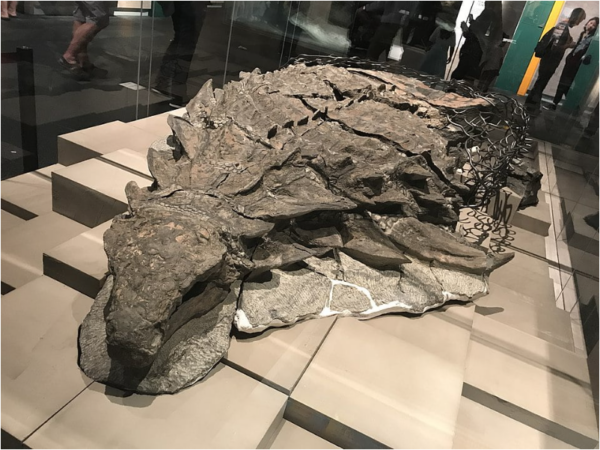
Recently Discovered Dinosaur ‘Mummy’ Is So Well-Preserved It Even Has The Skin And Guts Intact





“We Don’t Just Have a Skeleton – We Have a Dinosaur as It Would Have Been”
Recently Discovered Dinosaur ‘Mummy’ Is So Well-Preserved It Even Has Skin, Armor – and Guts – Intact
In what scientists are calling the most spectacular dinosaur fossil ever unearthed, a recently discovered nodosaur has stunned the paleontological world—not because of its bones, but because of what's still covering them.
“We don’t just have a skeleton,” said one researcher involved in the discovery. “We have a dinosaur as it would have been.”
This incredible specimen, now on display at the Royal Tyrrell Museum of Palaeontology in Alberta, Canada, is so impeccably preserved that it has been dubbed a "dinosaur mummy" rather than a traditional fossil. Found entirely by accident by miners at the Suncor oil sands near Fort McMurray, Alberta, the nodosaur is over 110 million years old, yet its body is nearly lifelike in appearance.
An Accidental Discovery That Changed Everything
In 2011, what started as a routine day at an oil sands mine turned into a once-in-a-lifetime moment for an excavator operator. While moving rock, the heavy equipment struck something unusually hard—and revealed a prehistoric treasure.
Buried deep within layers of marine sediment, the fossil turned out to be an exceptionally intact nodosaur, a type of heavily armored, plant-eating dinosaur from the Early Cretaceous period. The fossil was so remarkably preserved that the armor plates, skin texture, and even remnants of the dinosaur’s internal organs could still be seen.
Meet Borealopelta markmitchelli: The Tank of the Dinosaur World
Scientists have named the species Borealopelta markmitchelli, in honor of Mark Mitchell, the museum technician who spent more than 7,000 hours carefully chipping away the rock encasing the fossil. The process took years of delicate and painstaking work—but the result is nothing short of historic.
The dinosaur measured 5.5 meters (18 feet) long and weighed roughly 3,000 pounds (1,360 kg) in life. Astonishingly, the fossil still weighs around 2,500 pounds, due to the preserved body and mineralization that occurred over millions of years.
“It was built like a four-legged tank,” said one paleontologist. “And yet, despite all its armor, this animal still had to rely on camouflage to survive.”
The Science Behind the Preservation
How could such a massive creature remain so perfectly preserved for more than 100 million years? Researchers believe that shortly after the nodosaur died, it may have been swept away by a flooded river, eventually washing out to sea. There, it sank to the ocean floor, where it was quickly buried in sediment—a key factor in the remarkable preservation.
Over time, minerals infiltrated the skin and armor, replacing organic material and essentially “freezing” the body in its lifelike state. The result is a three-dimensional fossil, retaining not only the shape but also the texture and features of the original animal.
A Window Into a Lost World
What makes this nodosaur mummy even more extraordinary is the discovery of preserved skin pigments. Using mass spectrometry, scientists were able to detect actual chemical traces of melanin, revealing that the dinosaur had a dark reddish-brown coloration on its back and a lighter underside—a classic example of countershading used for camouflage.
“It’s like we’re looking at a living dinosaur,” one researcher said. “The coloration tells us about its behavior, its predators, and even its environment.”
This suggests the nodosaur needed to hide from predators—likely massive carnivores—despite its heavy armor. Its natural camouflage would have helped it blend into the ancient forest floors of what is now western Canada.
The Mona Lisa of Dinosaurs
Because of its lifelike preservation, three-dimensional integrity, and scientific significance, the nodosaur has been nicknamed "the Mona Lisa of dinosaurs." The level of detail is so high that scale patterns are still visible, and scientists didn’t need to speculate much to reconstruct the animal—it was almost ready-made.
“Just squint your eyes a bit,” one researcher said, “and you could almost believe it was sleeping.”
It is rare for any fossil to preserve soft tissue, let alone in such exquisite condition. This nodosaur gives us not just a skeleton, but a true glimpse into what dinosaurs actually looked like, how they lived, and how they adapted to their environments.
A Lasting Legacy
The fossil is now the centerpiece of the Royal Tyrrell Museum’s dinosaur exhibit, drawing visitors from around the world. Scientists continue to study it, hoping to unlock even more secrets about dinosaur biology, behavior, and evolution.
More than just a museum piece, this nodosaur mummy is a scientific time capsule—a snapshot from a lost world, preserved against all odds.
“It will go down in science history as one of the most beautiful and best-preserved dinosaur specimens ever discovered.”
And judging by the looks of it, the nodosaur isn't just history—it’s prehistoric life, frozen in time.
News in the same category


What Is the Longest River in the World? Top 5 Longest Rivers

The Monster Waves at Nazare, Portugal

Do Stoned Dolphins Give ‘Puff Puff Pass’ A Whole New Meaning?

Travel Coast-to-Coast by Train and See America’s Greatest Sites For Just Over $200

Sleepy Polar Bear Portrait Wins the Wildlife Photographer of the Year People’s Choice Award

Harvard Scientist Claims ‘Hostile’ Object Coming at Us Is Advanced ‘Mothership’ and Issues Warning

Lab-Made Butter Created From CO2 Tastes Like The Real Thing, Says Bill Gates

Man’s Refusal to Pay 25% Tip Ignites Debate on Tipping Culture

Universe Shaken: Rare Triple Black Hole Merger Sends Ripples Through Space-Time

The Sun Isn’t Yellow—It’s Pure White

The Sun’s Power: Earth Lives on Just 0.000002%

iPhone users issue warning on what to do if you get the 'caution' icon on your device

PlayStation 6 leak suggests release date could be much sooner than expected

Rolling Stone sues Google over AI summaries in landmark lawsuit

Tiny Brown Balls in Your Salad

A Man Held His Breath Underwater for 29 Minutes, Shattering the World Record and Even Surpassing Most Marine Mammals

Everywhere Cannabis Could Be Legalised in US as Trump Considers Major Law Change

Should You Peel Ginger Before Eating? The Shocking Truth Everyone Needs to Know
he peel is not harmful; in fact, it carries unique benefits. By using ginger correctly and storing it properly, you can unlock its full potential for boosting immunity, improving circulation, and keeping your
News Post

I Prepared a Cake for My Daughter’s Party, but Something Went Wrong

My Grandson’s Remark About His Stepmom Seemed Small, but It Led Me to a Bigger Discovery

The Power of an Unexpected Apology.

Put onion slices on the soles of your feet, great benefits, both men and women need

The Firefighter and the Mountain Lion.

Soak the stem with this water. When cooked, it will still be crispy and delicious, and will not cause itching

🧄🧅 Garlic and Onion: The Natural Secret to Better Hearing

Why Its So Important Not To Flush The Toilet After Every Trip

The Boy Who Brought Water to Half a Million Souls.

The Psychological Meaning of Leaving Dirty Dishes

Say Goodbye to Blocked Arteries with These Powerful Foods (Better Than Aspirin!)

What Is the Longest River in the World? Top 5 Longest Rivers

The Monster Waves at Nazare, Portugal

Do Stoned Dolphins Give ‘Puff Puff Pass’ A Whole New Meaning?

Travel Coast-to-Coast by Train and See America’s Greatest Sites For Just Over $200

Sleepy Polar Bear Portrait Wins the Wildlife Photographer of the Year People’s Choice Award

Oil Infusion For Fast Hair Growth

Most Widely Used High Blood Pressure Drug May Harm Heart Health, Study Shows
